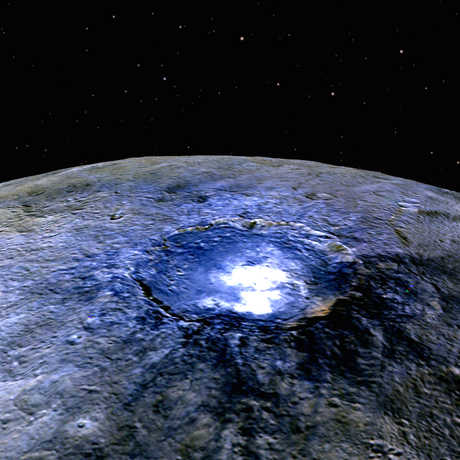Each month, renowned astronomers share their latest research at Morrison Planetarium.
Universe Update
The Origin of Organic Matter on Ceres

Ceres was an ancient Roman goddess that oversaw farming. Her name is even older than Rome, and actually means to grow and feed. Farmers no longer pray to the gods to make their crops grow, but we do keep deities’ names alive in the skies!
In 1801, Italian priest Giuseppe Piazzi discovered an object between the orbits of Mars and Jupiter. Since the rest of the asteroid belt had not yet been discovered, he assumed it was a planet and named it Ceres. We now know that Ceres is the largest object in the asteroid belt, so it qualifies as both an asteroid and a minor planet.
In 2007, NASA launched the Dawn spacecraft, to learn more about two of our largest asteroid neighbors. Dawn initially visited Vesta, the second largest object in the asteroid belt, and reached Ceres in 2015. In the past two years, the spacecraft has returned images that help researchers determine what Ceres is made of and how it formed.
Learning the history of Ceres can shed light on our own planet. The rocky planets of our Solar System formed when protoplanets merged into larger objects. Ceres may be like embryonic Earth from 4.5 billion years ago.
What have we learned from Dawn’s exploration? Recent studies found that Ceres may have had a liquid ocean in the past, and that organic material may have formed on the asteroid!
The rocky surface of Ceres appears to be solid materials such as ice, salts, and clathrate hydrates—a composite where water molecules form a cage-like structure around gas molecules. Much of the water from its proposed ancient ocean is contained in these materials. Scientists looked at how the surface of Ceres changed over time. The behavior of the flowing surface crust suggests a softer material lies beneath the surface. Researchers theorize that some of this softer stuff may be liquid water left over from long-gone oceans.
Organic compounds are materials that contain carbon. Examples are methane and amino acids—some of the key building blocks for life on Earth. By finding these materials on other objects in the Solar System, we learn more about how those materials may have arrived on Earth—and even shed light on the possibility that life could exist elsewhere in the Universe.
On Ceres, organic material tends to be clustered in specific areas. By simulating collisions of smaller asteroids, scientists determined that it is unlikely that organics came from other bodies. This result suggests that the material formed on Ceres, meaning that the building blocks of life appeared in multiple places in the Solar System independently!
Does this mean that an asteroid named for a life-giving goddess might actually have life on it? Finding organic material does not mean that there is life on Ceres. But it does suggest that the conditions for life may be common in the Universe.
Image: NASA/JPL-Caltech/UCLA/MPS/DLR/IDA


